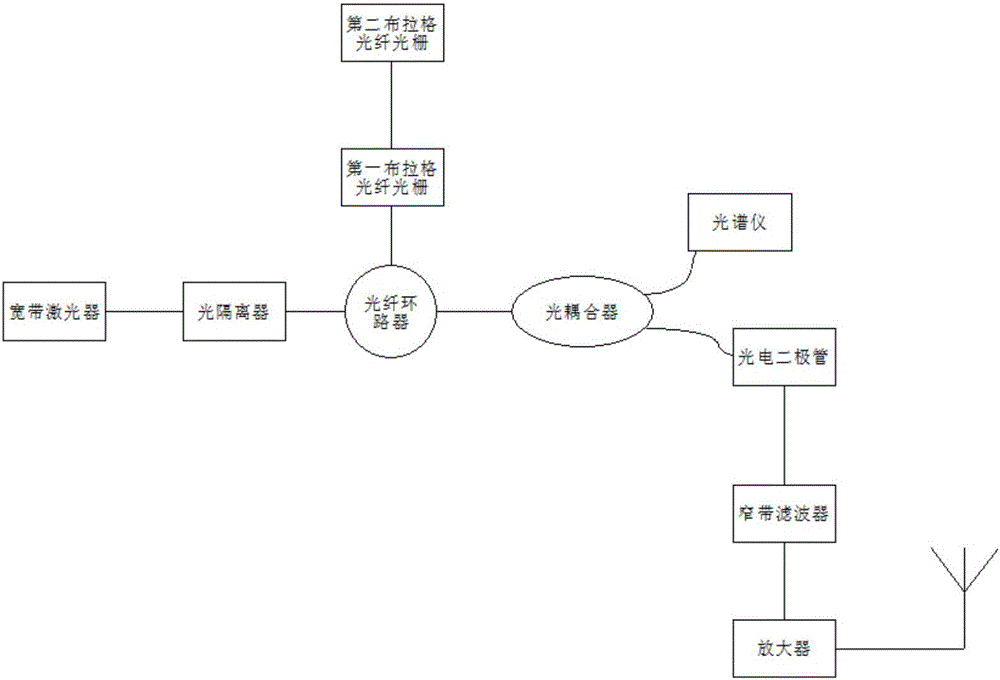Device for generating millimeter wave signals by using broadband light source
A broadband light source and millimeter wave technology, applied in the field of optical fiber communication and optical fiber sensing, can solve the problems such as the instability of the phase difference between optical signals cannot be guaranteed, the modulation mode of the microwave signal is fixed, the parameters of the microwave signal are limited, etc., and the phase relationship can be achieved. The effect of stability, low phase noise and simple structure
- Summary
- Abstract
- Description
- Claims
- Application Information
AI Technical Summary
Problems solved by technology
Method used
Image
Examples
specific Embodiment 1
[0028] like figure 1 As shown, a device for generating a millimeter wave signal using a broadband light source, including
[0029] a broadband laser for outputting optical signals of multiple wavelengths;
[0030] An optical isolator, connected to the broadband laser, is used to isolate reflected light to prevent interference with the broadband laser;
[0031] A fiber optic circulator, connected to the optical isolator, is used to transmit optical signals to the first Fiber Bragg Grating and the second Fiber Bragg Grating and receive reflected optical signals of the first Fiber Bragg Grating and the second Fiber Bragg Grating;
[0032] The first fiber Bragg grating is connected with the optical fiber circulator, and is used for selectively outputting the optical signal input by the optical fiber circulator and narrowing the output optical signal;
[0033] The second fiber Bragg grating is connected to the first fiber Bragg grating, and is used for selectively outputting the ...
specific Embodiment 2
[0047] It is roughly the same as the specific embodiment 1, and the only difference is that the wavelengths of the optical signals selected by the first fiber Bragg grating and the second fiber Bragg grating are different.
[0048] If the wavelength of the optical signal selected by the first fiber Bragg grating is λ 1 =1549.64nm, the wavelength of the optical signal selected by the second fiber Bragg grating is λ 2 =1550.36nm, the generated millimeter wave signal Δλ=0.72nm (ie Δv=90GHz);
[0049]If the wavelength of the optical signal selected by the first fiber Bragg grating is λ 1 =1550nm, the wavelength of the optical signal selected by the second fiber Bragg grating is λ 2 =1551nm, the generated millimeter wave signal Δλ=1nm (ie Δv=125GHz);
specific Embodiment 3
[0050] It is roughly the same as that of the specific embodiment 1, and the only difference is that the wavelengths of the optical signals selected by the first fiber Bragg grating and the second fiber Bragg grating are different.
[0051] If the wavelength of the optical signal selected by the first fiber Bragg grating is λ 1 =1549.04nm, the wavelength of the optical signal selected by the second fiber Bragg grating is λ 2 =1550.96nm, the generated millimeter wave signal Δλ=1.92nm (ie Δv=240GHz);
[0052] If the wavelength of the optical signal selected by the first fiber Bragg grating is λ 1 =1548.8nm, the wavelength of the optical signal selected by the second fiber Bragg grating is λ 2 =1551.2nm, the generated millimeter wave signal Δλ=2.4nm (ie Δv≈300GHz)
PUM
 Login to View More
Login to View More Abstract
Description
Claims
Application Information
 Login to View More
Login to View More - R&D
- Intellectual Property
- Life Sciences
- Materials
- Tech Scout
- Unparalleled Data Quality
- Higher Quality Content
- 60% Fewer Hallucinations
Browse by: Latest US Patents, China's latest patents, Technical Efficacy Thesaurus, Application Domain, Technology Topic, Popular Technical Reports.
© 2025 PatSnap. All rights reserved.Legal|Privacy policy|Modern Slavery Act Transparency Statement|Sitemap|About US| Contact US: help@patsnap.com

